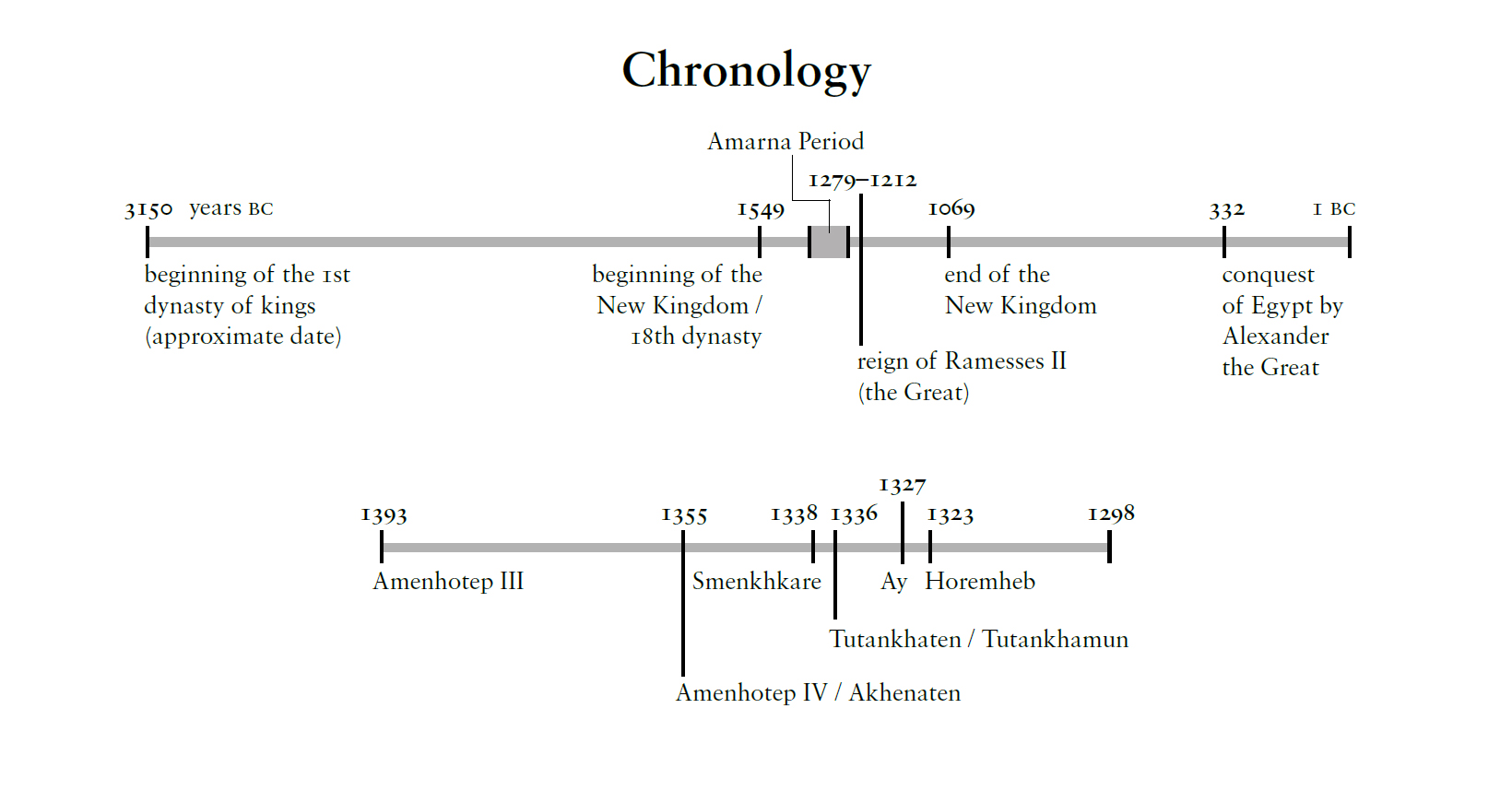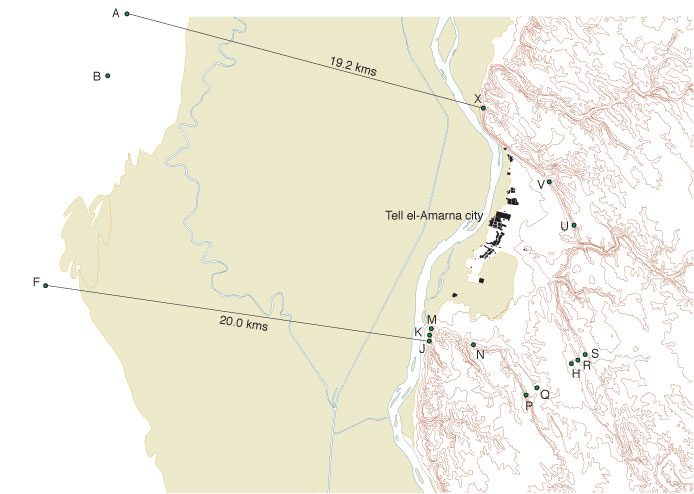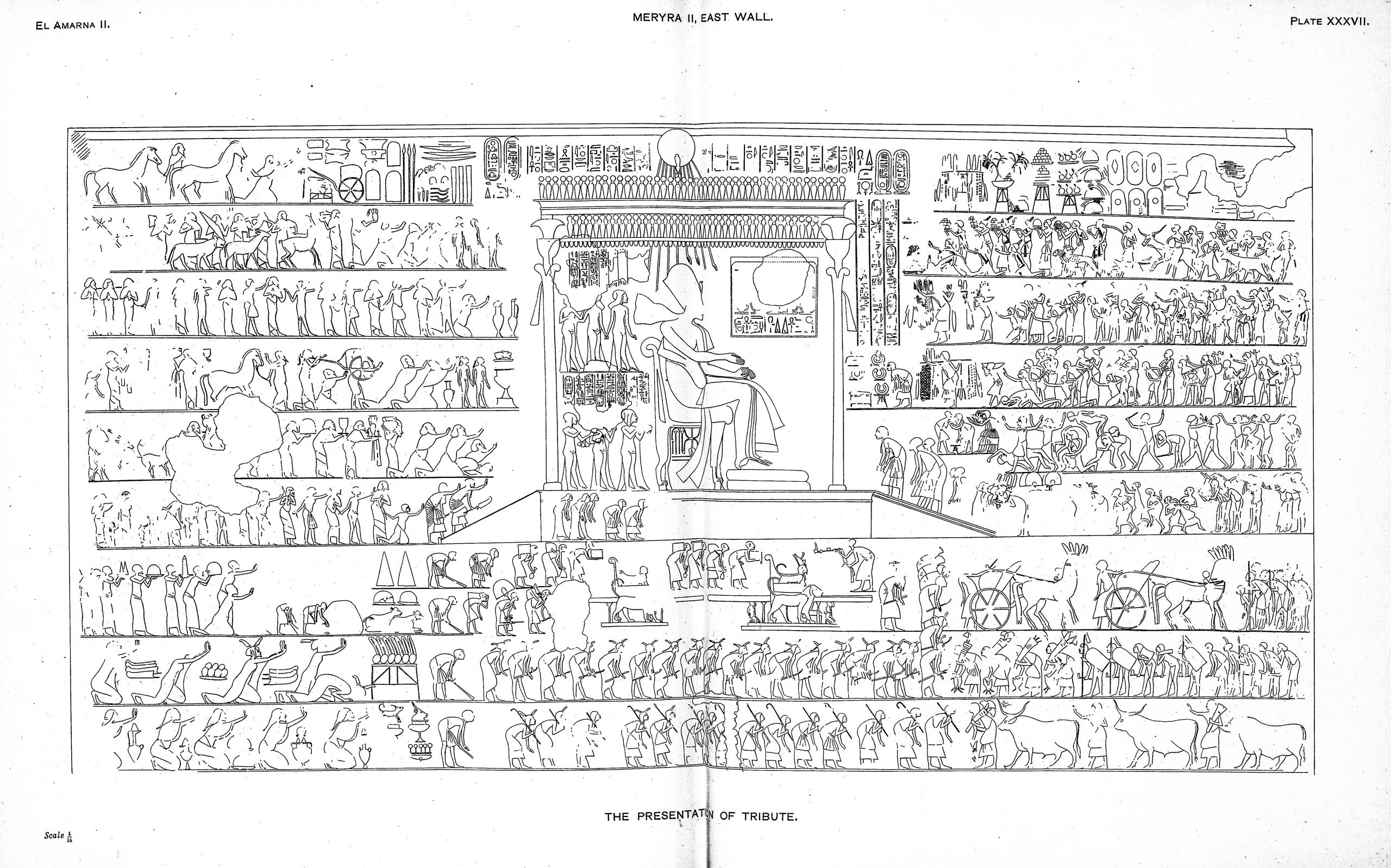The Amarna Period took place at the end of the 18th Dynasty in Egypt between 1353-1322 BCE and refers to the reigns of pharaoh’s Amenophis IV (Akhenaten), Nefernefruaten, Smenkhkare, and Tutankhamun, see Figure 1. The 18th Dynasty was a period which started the New Kingdom era and was also noted for the reign of Hatshepsut (c.1473-1458 BCE), the second confirmed female pharaoh. Under the reign of Amenophis III / Amenhotep III (c.1390-1353 BCE), Egypt saw unprecedented prosperity and reached the peak of its artistic and international power. Amenophis III embarked on many construction projects including the expansion of the temple of Karnak and the Colossi of Memnon built to guard the entrance to his mortuary temple the largest to have been built in Egypt (Kozloff, 2012, pp. 122–124). Before his death, Amenophis III had created more statues of himself than any other pharaoh totalling over 250 and was known as Amenhotep the Magnificent. However, at the time of his death the Amun priesthood, the most powerful of the religious cults, had grown in wealth to a point where they were a religious and political power potentially rivalling that of pharaoh (Reeves, 2019).

Figure 1, chronology of the Amarna Period (Kemp, 2012, p. 304)
After the death of Amenophis III his son Amenophis IV became pharaoh and proclaimed that both his father and the sun-god Aten had become one; a move towards re-establishing the divinity of the pharaoh. This meant that the kingship past, present, and future were fused as one divine entity through the Aten (Reeves, 2019). By elevating his father to that of a divine being and positioning himself as the sole earthly connection to him, Akhenaten was beginning a calculated move to ensure pharaoh was the supreme power throughout Egypt. By becoming the sole representative and ‘high priest’ of the Aten, the only way the people could connect with the Aten was through Akhenaten. To indorse this religious move, in year 5 of his reign, Amenophis IV changed his name from Amenophis, ‘The god Amun is content’, to Akhenaten, ‘He who is effective on the Aten’s behalf’.
To secure his new religion Akhenaten had to dismantle the power of the other religious sects and the most complete way of doing this was to abandon both Memphis, Egypt’s administrative capital and Thebes, the religious centre. A new religious and administrative capital would be built at the mid-point between the two from which the pharaoh could rule under the one god, the Aten. The location of the new city was to be on virgin land, untouched and unoccupied, therefore politically neutral. The cliffs to the east of the chosen site included a small valley entrance gap which resembled the hieroglyph akhet, ‘horizon’, where the sun-god would be reborn at the start of each day. The ‘Horizon of the Aten’ or Akhet-Aten was the name given to the area within which was built the city.
The move to Akhetaten began with the marking of the boundary through a series of proclamations carved into rock-cut stelae as to the extents of and structures to be constructed within Akhetaten. The first of the stelae to be discovered in modern times was by Claude Sicard in 1714 and has been given the name stela A with the remaining stelae also following an alphabetic nomenclature. The total number of stelae found to-date is 15 and their locations are shown in Figure 2.

Figure 2, locations of the boundary stelae (Barry Kemp)
Akhenaten set out in his proclamation what structures would be built (Kemp, 2017) and these included the House of Aten, the Mansion of the Aten, the Sun Temple for Nefertiti, the House of Rejoicing (for jubilee festivals), the Pharaoh’s Residence, and a residence for Nefertiti. In the cliffs he declared that his tomb and those of his wife Nefertiti and their daughter Meritaten would be constructed. Akhenaten also declared that a tomb for the Mnevis bull would be created, showing a tolerance to other religions which is slightly at odds with the general thinking regarding perceived fanatical monotheistic ideology. Within the northern cliff’s, tombs for his high advisers and priests would be built and to the south, tombs for high officials.
The construction of Akhetaten began with the building of the first altar to the Aten which would later become the Small Aten Temple. To the north of this was constructed a small palace and beyond this a larger temple was begun which would become the Great Aten Temple. The North and South Palaces followed shortly after and in year 6 Akhenaten moved his whole court to Akhetaten.
The Aten was not represented as a statue to be worshiped within a dark chamber deep inside a temple. The temple architecture did not follow the enclosed structures normally found elsewhere in Egypt and were built as open-air constructs to allow direct access to the sun-god. This design was a continuation of the Gem-pa-Aten (‘the Aten is found’) temple structure constructed by Akhenaten at Karnak a few years earlier (Montserrat, 2000, p. 15). As the god was visible throughout the daylight hours, the Aten was presented as a solar disk with its rays stretching outwards terminating in hands which, in later versions, would each hold an ankh, the symbol for ‘life’. The disc form of the Aten, along with the royal family worshiping it, decorated the temples and palaces throughout Akhetaten. The presence of the Aten is always shown as showering its rays of light only on the royal family and no one else, reaffirming the power of Akhenaten; a confusing situation given the sun-drenched nature of Egypt. The priestly hierarchy and daily routine of the old religion was streamlined (Teeter, 2011, p. 193) and the Aten priesthood’s primary function dealt with the daily offerings and acting as the servants of the god, which by default meant the pharaoh as the sole representative on earth.
Religion and politics have always brought about power struggles and bloodshed and, although we do not know the extent as to the dangers within the royal court, we can be confident that pharaoh would need to maintain a heightened state of security during the changes he was making. We also know that the idea of relocating the capital was not a new one for Egypt. The founder of the 12th Dynasty, Amenemhat I also known as Ammenemes I (1991-1962 BCE), had previously abandoned Thebes to establish a new capital named Amenemhat-itj-tawy (Itjtawy), in the Faiyum region. Unfortunately for Ammenemes I he was assassinated by his own guards while his son, Senusret I was on a campaign in Libya (Simpson, 2003a). The events are recorded in ‘The Teaching of King Ammenemes I to His Son Sesostris’ (Simpson, 2003b), written during the early Middle Kingdom (2040-1782 BCE) as is the first reported mention of the ‘itn’, Aten as a deity. It is highly likely that Akhenaten was aware of the teaching of Ammenemes I, recorded in the 18th Dynasty ‘Papyrus Millingen’, as two ostraca have been discovered at Amarna which mention the text (Parkinson, 2000).
It is fair to say that Akhenaten’s actions led to possibly the single biggest upheaval in ancient Egypt, affecting every level of society. The many gods to which the people relied on for daily assistance, had been demoted. The powerful cults of Amun, Horus, Isis, Osiris their statues, processions, rituals, and the offerings associated with them were suppressed. It is possible that the subjugation of these complex cults may have appealed in its simplicity to some Egyptians, but in doing so it also removed the infinite ways one could ask the gods for assistance and protection during daily life (Teeter, 2011, p. 186). How did they react to the loss of a god which was powerful one day and not the next? Did this invalidate their previous prayers and offerings? The priests had lost their power and financial income, what were they to do? The temple support staff and craftsmen employed to produce objects necessary for worship were also out of work. The transition was not likely to be easy and resentment certainly built up however it is entirely plausible that Akhenaten did not enforce the sole worship of the Aten but rather promoted the Aten as the most powerful, to which all others were subservient much in the way that Amun had been prior. Evidence of this can be seen at Amarna where the religion of the old gods continued albeit at a much less obvious way through private worship (Kemp, 2012). Akhenaten may have been a religious fanatic, or he could have been a ruthless politician, but he must also have been aware of the fate of Ammenemes I and would need to ensure he did not succumb to the same fate. The overthrow of the Amun priesthood and the construction of Akhetaten was only part of his plan and it was his religious reforms that would ensure the loyalty of his subjects.
For a millennia people had believed that the darkness of night (and the afterlife) was inhabited by demons, gods, and all sorts of horrors which would devour all those who did not live their lives honourably. The fate of an individual had always been in their own hands and that by living a virtuous life they would be rewarded with a rich and good life in the hereafter. However, in the Amarna Period the realm of the dead was simply the absence of light (and life) from the Aten. It was Akhenaten, as the earthly representative of the Aten, who gave life after death and as such the safety of the eternal soul was not found through the good deeds you did in life but in your devout service to the pharaoh. This is evidenced in the tomb paintings which traditionally would have focused on the daily life and achievements of the deceased alongside their dutiful worship of the gods. In the Amarna tomb paintings, the occupant is relegated to a small figure and the focus is on the royal family worshipping the Aten and bestowing gifts to the deceased for loyal service. It was palace life and the processional activities of the royal family throughout the city which were made large, not the residence or accomplishments of the deceased. The tomb occupant no longer had any real control over their own eternal life, which was at the mercy of the pharaoh. Traditional belief also held that the ba (energy) of the deceased would leave the tomb at sunrise as a human-headed bird and re-join the living, free to go where it pleased and drink from the Nile. In the Amarna Period the ba was allowed to visit the city, mix with the living, enjoy the rays of the Aten, and eat the ‘unused offerings of your father Aten’ from the altars in the Great Aten Temple (Murnane, 1995, p. 112). Akhenaten was not only the almighty power in life, but he was in complete control of the afterlife. The people had to pledge their loyalty or risk their very existence in eternity.
Between years 8 and 12 Akhenaten refocused his attention back to the cult of Amun who had continued to function albeit in a reduced capacity in opposition to the new religion. This time a true persecution was to take place as Akhenaten instigated a purge of the god Amun’s name from all monuments. The fear was so great that the Egyptian people themselves ground out and removed the name of Amun from personal possessions to not be caught. Paranoia gripped the population; there was a real danger that watchful eyes were ready to inform on one another to the authorities (Reeves, 2019, p. 152).
If Akhenaten was moving towards establishing total control of his people, the same cannot be said for the foreign powers. Akhenaten was so concerned with his domestic issues that he neglected his foreign affairs. The Amarna tablets show evidence of this as correspondence between Egypt and its foreign territories (Moran, 1992; Mynářová, 2007; Rainey, 2015). This was most noticeable in year 12 when a revolt occurred in Nubia and Akhenaten ordered the King’s son of Kush, Thutmose the Viceroy of Nubia, to deal with it. In the north towards Syria, vassal kings pleaded with Akhenaten for support to quell local fighting between countries for fear of losing their lands. However, in the same year 12 there is evidence of foreign dignitaries paying tribute to Akhenaten and Nefertiti, probably at the site of the Desert Altars, depicted in the tombs of Huya and Meryre II shown in Figure 3.

Figure 3, paying tribute to Akhenaten in year 12, tomb of Meryra II (de G. Davies, 1905, p. pl. XXXVII)
The period between year 12 and 14 brought sorrow to Akhenaten’s’ court in the death of Meketaten the second daughter of Akhenaten and Nefertiti, along with Kiya the secondary wife of Akhenaten, and Queen Tiye the mother of Akhenaten. In grief it may have been that Akhenaten decided to focus on a rebuild of the Great Aten Temple as there is evidence of the site being cleared in part and a rebuild having taken place at this time (Kemp, 2014, p. 6).
The last few years of Akhenaten have caused much debate. Nefertiti may have ruled alongside him as coregent (alluded to in the tribute wall painting where she is sitting alongside her husband as an equal) or have fallen out of favour for possibly moving away from the Atenist religion back towards the old gods. In year 17 Akhenaten died and his successor was named as Neferneferuaten or Smenkhare. Scholars have argued whether this was a brother of Akhenaten, another son of his, or Queen Nefertiti (Aldred, 1968; Kemp, 2012; Reeves, 2019). However, within two years this king disappeared from the record, and Tutankhaten ascended the throne transferring the capital back to Thebes, reinstating the worship of the old gods in the process, and changing his name to Tutankhamun. Within nine years he too would be dead whether through illness or foul means and his successor Ay took the throne. This again was to be a short reign as four years later General Horemheb succeeded in becoming the last pharaoh of the 18th Dynasty.
Horemheb ensured that the ‘heretic’ Pharaoh Akhenaten and his successors Neferneferuaten, Smenkhkare, Tutankhamun, and Ay were removed from the historical record. As part of this, Horemheb had all representation of these Pharaohs erased from public record and began the systematic dismantling of the city at Amarna. The inscribed King’s Lists at Abydos (inscribed 1290-1279 BCE) and Saqqara (inscribed 1279-1213 BCE) both show Horemheb immediately following Amenhotep III, Akhenaten’s father, as Pharaoh (Figure 4). As time passed it may have been that the memory of the Amarna period faded. However, by the third century BCE the Egyptian priest Manetho wrote a history of Egypt in Greek, the Aegyptiaca, an important source of information regarding the chronology of the pharaohs of ancient Egypt (Waddell, 1940). Manetho constructed the king list in the form of dynasties where the kings were grouped by location or extended genealogy, establishing a framework still in use today. The 18th dynasty Amarna period pharaohs are difficult to determine accurately, with Akhenaten potentially identified as Chenchres or Akencheres (St. J. Thackeray, 1926, p. 200). It is during the reign of ‘Achencheres’ that Manetho states Moses became the leader of the Hebrews in their exodus from Egypt and thereby fuelling the minds of many modern authors as to a connection between Akhenaten and Moses (Waddell, 1940, p. 119; Montserrat, 2000; Osman, 2011).

Figure 4, Royal Cartouches of the 18th Dynasty Pharaohs at Abydos. No 73 is Amenhotep III and No 74 is Horemheb.
(image Wikimedia Commons)
The Amarna Period, although short lived, is a fascinating narrative but one which plays out at the topmost levels of society. The city of Akhetaten at Amarna however allows for the stories belonging to its inhabitants to be explored as a snapshot of Egyptian life during this period. Expeditions and surveys conducted since the 1700s have brought about a wealth of archaeological material much of which can be used to construct the environment as it may have been in antiquity along with the daily activities of those who lived there at the time.
Bibliography
Aldred, C. (1968) Akhenaten: Pharaoh of Egypt. London: Thames and Hudson.
de G. Davies, N. (1905) The Rock Tombs of El Amarna: Part II. The Tombs of PANEHESY AND MERYRA II. London: Egypt Exploration Society.
St. J. Thackeray, H. (1926) Josephus. With an English translation. In Eight Volumes. Vol. 1: The Life / Against Apion. London: William Heinemann.
Kemp, B. (2012) The city of Akhenaten and Nefertiti: Amarna and its people. London: Thames and Hudson.
Kemp, B. (2014) ‘Horizon 15’, The Amarna Project and Amarna Trust newsletter. Cambridge, U.K.: The Amarna Trust.
Kemp, B. (2017) Amarna the Place: Boundary Stelae, The Amarna Project. Available at: https://www.amarnaproject.com/pages/amarna_the_place/boundary_stelae/index.shtml (Accessed: 14 February 2020).
Kozloff, A. P. (2012) Amenhotep III: Egypt’s Radiant Pharaoh. Cambridge University Press.
Montserrat, D. (2000) AKHENATEN: History, fantasy and ancient Egypt. London/New York: Routledge.
Moran, W. L. (1992) The Amarna Letters. London: John Hopkins University Press.
Murnane, W. J. (1995) Texts from the Amarna Period in Egypt. Atlanta: Scholars Press.
Mynářová, J. (2007) Language of Amarna – Language of Diplomacy. Prague: Czech Institute of Egyptology, Charles University in Prague/Agama.
Osman, A. (2011) Moses and Akhenaten: The Secret History of Egypt at the Time of the Exodus. Vermont: Bear and Company.
Parkinson, R. B. (2000) ‘The Teaching of King Amenemhat I at el-Amarna: EA 57458 and 57479’, in Leahy, A. and Tait, W. J. (eds) Studies on Ancient Egypt in Honour of H. S. Smith. London: Egypt Exploration Society, pp. 221–6.
Rainey, A. F. (2015) The El-Amarna Correspondence (2 vol. set): A New Edition of the Cuneiform Letters from the Site of El-Amarna based on Collations of all Extant Tablets. Edited by W. M. Schniedewind and Z. Cochavi-Rainey. Leiden / Boston: Brill.
Reeves, N. (2019) Akhenaten: Egypt’s False Prophet. London: Thames and Hudson.
Simpson, W. K. (ed.) (2003a) ‘The Story of Sinuhe’, in The Literature of Ancient Egypt: An Anthology of Stories, Instructions, and Poetry. Yale University Press.
Simpson, W. K. (ed.) (2003b) ‘The Teaching of King Amenemhet I for his son Senwosret’, in The Literature of Ancient Egypt: An Anthology of Stories, Instructions, and Poetry. Yale University Press.
Teeter, E. (2011) Religion and Ritual in Ancient Egypt. Cambridge University Press.
Waddell, W. G. (1940) Manetho, with an English translation. Cambridge, Mass.: Harvard University Press.
